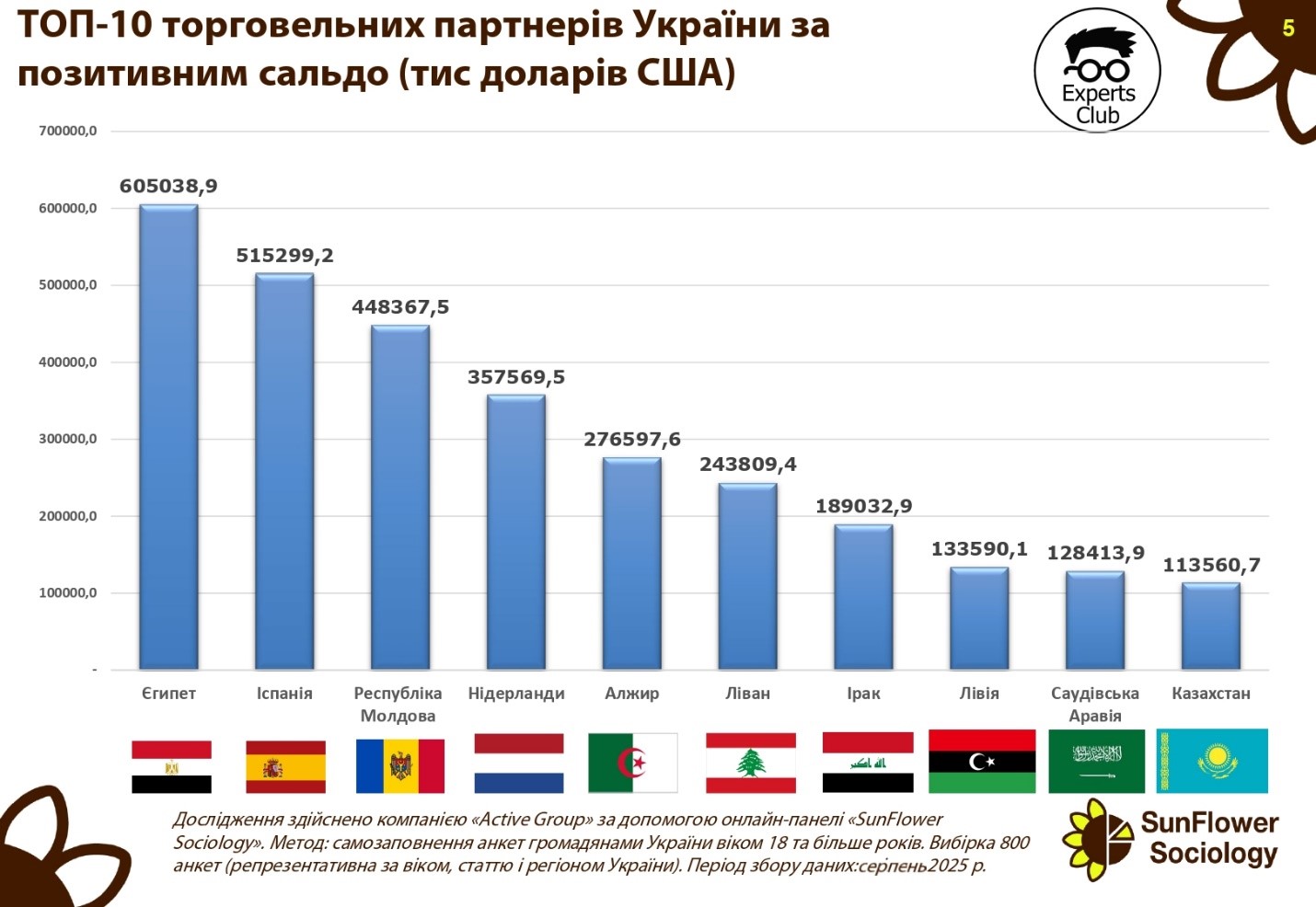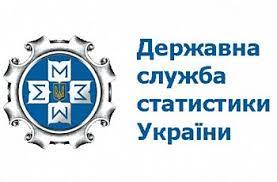
Ukraine’s positive foreign trade balance in services in January-September 2025 decreased by 47.3% compared to the same period in 2024, to $856.8 million (in January-September 2024, it was $1,652.8 million), the State Statistics Service reported on Friday.
According to its data, exports of services for the nine months of 2025 decreased by 15.7% to $6,338.7 million, while imports decreased by 7% to $5,481.9 million.
The export-to-import coverage ratio was 1.16 (1.28 for the first nine months of 2024).
Foreign trade operations were conducted with partners from 211 countries around the world.
The structure of foreign trade in services for the first nine months of 2025 can be found at:

Ukraine’s negative foreign trade balance in goods in January-September 2025 increased by 50% compared to the same period in 2024, to $30.619 billion from $20.403 billion, the State Statistics Service (SSS) reported on Friday.
According to its data, exports of goods from Ukraine during the specified period decreased by 4.1% compared to January-September last year, to $29.572 billion, while imports increased by 17.5%, to $60.191 billion.
The statistics agency specified that in September 2025, compared to August 2025, seasonally adjusted export volumes decreased by 1.0%, and imports by 4.2%.
The seasonally adjusted foreign trade balance in September 2025 was negative and amounted to $3.612 billion, while in the previous month it was also negative at $3.874 billion.
The export-to-import coverage ratio was 0.49 (0.60 for the first nine months of 2024).
Foreign trade operations were conducted with partners from 222 countries around the world.

In terms of total trade volume, Ukraine cooperates most closely with China, Poland, and Germany. These countries form the basis of the state’s foreign economic relations, exerting a critical influence on imports and exports.
China remains the leader with a total trade volume of $8.99 billion. Poland ranks second with $6.04 billion, while Germany and Turkey are almost equal with $4.28 billion and $4.25 billion, respectively. The United States ranks fifth with $2.86 billion.

The top 10 also includes Italy ($2.38 billion), the Czech Republic ($1.64 billion), Bulgaria ($1.54 billion), Hungary ($1.53 billion), and Romania ($1.50 billion).
“The top ten partners form the basis of Ukraine’s foreign trade balance. China and the EU countries account for the largest volumes of trade, but it is important to take into account the significant negative balance in relations with these countries,” said Maksim Urakin, founder of Experts Club and economist.
He added that although the large volume of trade indicates Ukraine’s integration into global supply chains, dependence on imports from China and Europe creates strategic risks.
“Poland and Germany are key hubs for Ukrainian exports, but at the same time they are significant sources of imports. Therefore, it is critically important to balance trade flows, preserving positive sectors such as agriculture and metallurgy, and reducing dependence on critical imports,” Urakin noted.
BULGARIA, CHINA, CZECH REPUBLIC, ECONOMY, EXPERTS CLUB, FOREIGN TRADE, GERMANY, HUNGARY, ITALY, POLAND, ROMANIA, TURKEY, UKRAINE, USA, МАКСИМ УРАКИН

Ukraine maintains a significant positive trade balance with a number of key partners, which partially offsets the deficit in relations with China and EU countries.
The largest surplus in the first half of 2025 was recorded in trade with Egypt — $605.0 million. Spain ranks second with a balance of $515.3 million, followed by the Republic of Moldova — $448.4 million. Positive dynamics are also observed in relations with the Netherlands ($357.6 million), Algeria ($276.6 million), and Lebanon ($243.8 million).
Ukraine also has a high trade surplus with Iraq ($189.0 million), Libya ($133.6 million), Saudi Arabia ($128.4 million), and Kazakhstan ($113.6 million).

“The positive trade balance indicates that Ukraine is capable of competing effectively in international markets, especially in the agricultural sector and metallurgy. At the same time, it should be borne in mind that these markets are vulnerable to changes in the global economic situation, price fluctuations, and political factors,” emphasized Maksim Urakin, founder of Experts Club and economist.
According to him, maintaining a positive balance in relations with the countries of the Middle East and North Africa is a key element of Ukraine’s foreign trade strategy.
“Egypt, Spain, and the countries of the Arab world are stable importers of Ukrainian agricultural products. This is a strategic direction that needs to be developed further, as it creates a safety cushion for the economy against the backdrop of significant import costs,” Urakyn emphasized.
Analysts note that consolidating positions in the African and Middle Eastern markets could become a long-term factor in strengthening Ukraine’s foreign economic balance.
Agricultural exports, ALGERIA, ECONOMY, EGYPT, EXPERTS CLUB, FOREIGN TRADE, IRAQ, KAZAKHSTAN, LEBANON, LIBYA, MOLDOVA, NETHERLANDS, positive balance, SAUDI ARABIA, SPAIN, UKRAINE, МАКСИМ УРАКИН

Ukraine’s foreign trade deficit in goods in January-June 2025 increased by 48.9% compared to the same period in 2024, to $18.512 billion from $12.430 billion, the State Statistics Service (Gosstat) reported on Thursday.
According to its data, exports of goods from Ukraine during the specified period compared to January-June 2024 decreased by 4.2% to $20.045 billion, while imports increased by 15.6% to $38.557 billion.
Gosstat specified that in June, compared to May of this year, seasonally adjusted export volumes decreased by 5.6% to $3.321 billion, while imports increased by 2.8% to $7.186 billion.
The seasonally adjusted foreign trade balance in June 2025 was negative at $3.865 billion, while in the previous month it was also negative at $3.465 billion.
The export-to-import coverage ratio for the first six months of 2025 was 0.52 (in January-June 2024, it was 0.63).
The State Statistics Service specified that foreign trade operations were conducted with partners from 221 countries around the world.
Earlier, the Experts Club information and analytical center made a video analysis of the prospects for the Ukrainian and global economies. For more details, see the video — https://youtu.be/kQsH3lUvMKo?si=F4IOLdLuVbYmEh5P

The negative balance of Ukraine’s foreign trade in goods in January 2024 decreased by 11.7% compared to the same month in 2023 – to $1.678 billion from $1.9 billion, the State Statistics Service (Gosstat) said on Friday. According to its data, exports of goods from Ukraine in January 2024 compared to January 2023 increased by 8.2% to $3.4 billion, while imports increased by 0.7% to $5.078 billion.
The State Statistics Committee specified that in January-2024 compared to December-2023 seasonally adjusted exports increased by 7.4% to $3.47 billion, while imports remained virtually unchanged at $5.536 billion.
The seasonally adjusted foreign trade balance in January-2024 was negative at $2.066 billion, while December-2023 also recorded a negative balance of $2.304 billion.
The coefficient of export coverage of imports in January 2024 amounted to 0.67 (in January 2023 – 0.62).
State Statistics specified that foreign trade operations were conducted with partners from 191 countries. Analytical Center Experts Club presented a video analysis of the main trends in the economy of Ukraine and the world – https://youtu.be/w5fF_GYyrIc?si=vN_Jp0fh8u1xN_U2.